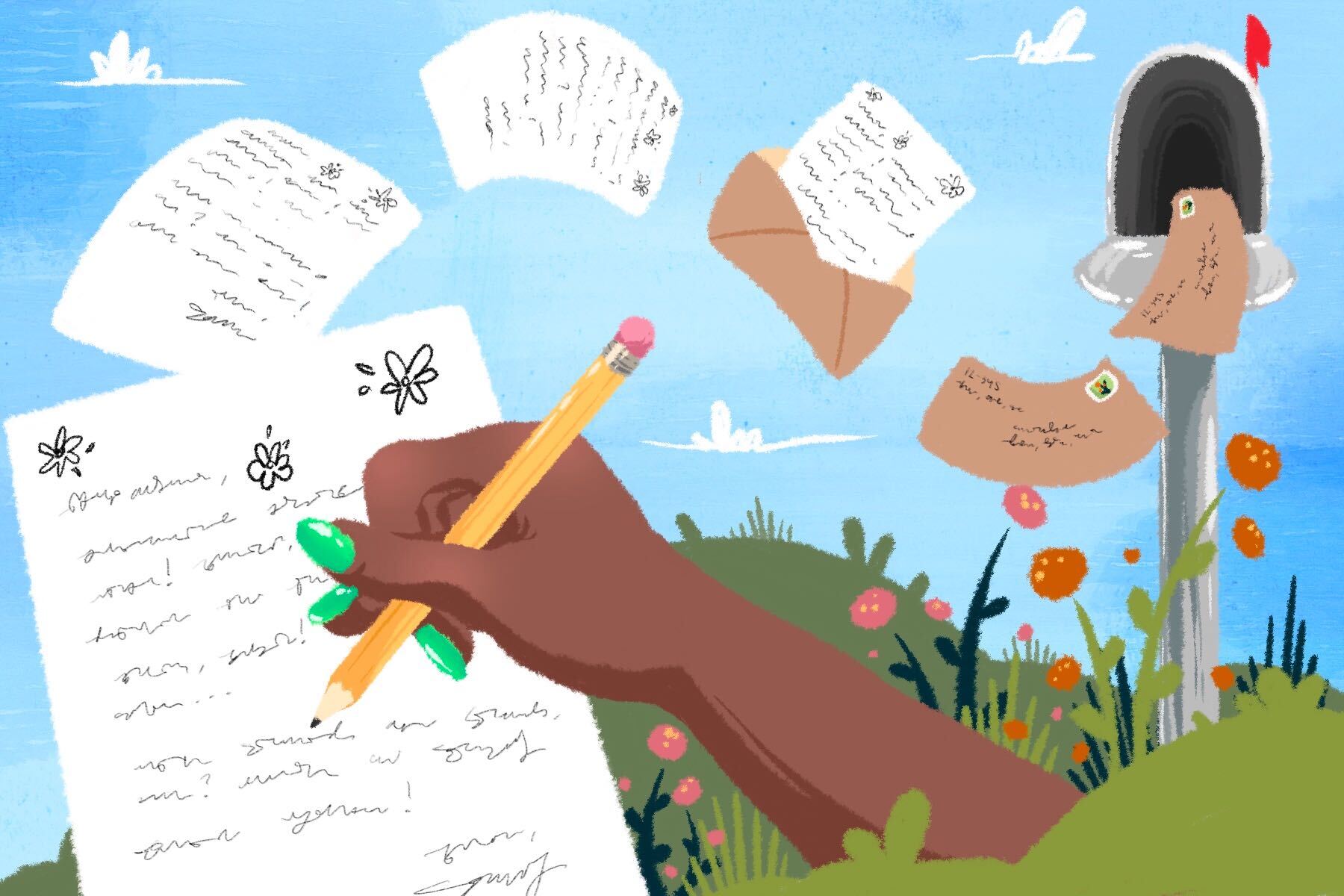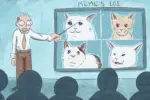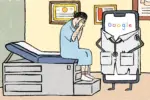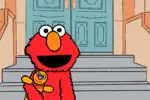The letters became the closest thing that I had to a routine. At the beginning of quarantine, I was afraid of my journal. I didn’t know how to be honest with it. There was nothing I wanted to memorialize with the intimacy of my own handwriting. Yet, writing has always been my most familiar coping mechanism, so I started sending my friends mail as a way of navigating the new conditions of our relationships through becoming pen pals.
I turned film photos into postcards, filled with mini playlists and DIY crossword puzzles. Becoming pen pals during quarantine initiated the empowerment of adaptation, challenging the dullness of each day with the arrival of a letter.
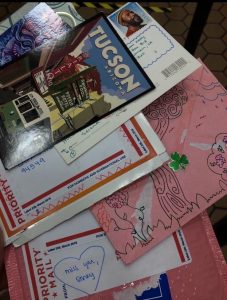
I have had pen pals since high school — a habit that followed me into college as the distance between me and my friends grew. I’ve always loved mail and its ability to provide an authentic connection in a way feels innately different than a text message. However, sending mail often got lost in the blur of school, work and the way being a 20-something occupies time on its own.
With social distancing and its endless Zoom meetings, revisiting a devotion to letter writing seemed to offer a familiar emotional depth similar to seeing my friends in person. More specifically, becoming pen pals during quarantine worked to maintain a form of physical connection in a period without touch. As the conversation surrounding Gen Z and millennials often basks in critiques of self obsession and low attention spans, the letters I received from my friends portray a different narrative.
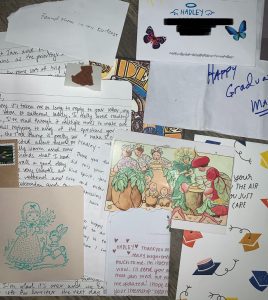
Hadley and I have been writing to each other for a few years now. But during quarantine the topics of our letters changed; losing our jobs, ways to distract ourselves to keep busy and the songs helping us get by filled our letters. Hadley graduated this spring, illuminating the way in which carefully laid plans can fall apart in an instance, an empty ache everyone seemed to collectively understand.
Hadley says, “Sending mail has always helped me; it brightens my day. Choosing the card —- or more often than not, a torn piece of paper, sticky note or receipt in my cases —- and writing to someone you care for. It keeps me on my toes and looking forward to something . . . [L]etter writing teaches me to be patient, and to be eager. It helps me see the words in my head, often lending a new perspective. It humbles me, showing all the mistakes I make. It makes me feel more loved, appreciated and seen by those I exchange letters with.”
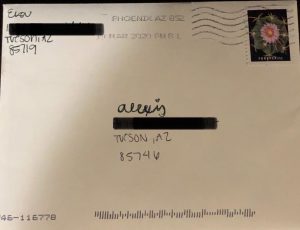
“I chose to write a letter to my mother for the first time ever. I felt that in that letter I was able to connect to her on a deeper level than I have ever before. My true feelings and thoughts were brought to life through my words. I think that may be because my thoughts do not get interrupted as they would in person,” said Alexis Ruiz. “I can communicate everything I want to say without the instant satisfaction of a response. That also adds to the rewarding feeling to receive a letter in return. I want to continue writing letters as a form of communication for as long as I possibly can.”
As this year builds its momentum on collective resistance, conversations between friends follow suit. “How are you” and “what did you do today” increasingly become intertwined with systemic racism and a lingering pandemic. “[The pandemic] has shown everyone how unserved some communities are, especially those that are populated majorly by minorities. The lack of resources has always been there – it’s our history,” said Ruiz.
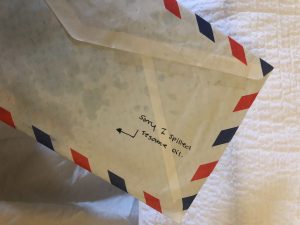
“In the light of all of this, it is beautiful how some have made their efforts to help each other out as we know we cannot rely on the government to do so. Lastly, we are moving towards a transition that will create a better society for the next generation to come. It is going to be a process —- a very long one, and I am aware of that. I am thankful for the way what is wrong with our society has been revealed. I look forward to the changes we are making to this world. ‘Normal’ will never return.”
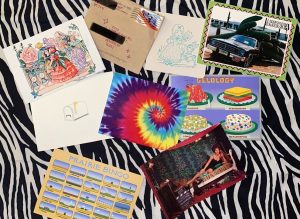
Letter writing began to feel like the diary entries I was initially afraid of writing, prompting explorations regarding the shared new realities between me and my friends. “The time it takes, even just writing the card and sending it, is just intimate and nice to me. It did help me heal, and writing what I thought of was also nice to send out…. [I] do and do not want to go back to [life] pre-corona,” said Natalie Benitez. “I think corona helped a lot of people realize a lot of social issues we were having, and a lot came from the pandemic. And because of that I don’t want to go back to [life] pre-corona, but I do miss having my outdoor routine.”
Adjustment and growth have become common themes within our conversations, paired with vignettes about learning to roller skate, going to protests, reflections about the future and small but significant self discoveries.
Some time in early March, my friend Molly and I went to Savers with my friend Silvia, got a pizza afterwards and hung out at my house as I turned shirts into crop tops. It was the last time we would see each other for months. So, we made a list of things to do “post-pandemic” (whenever that is) with things like getting ramen, filling up a roll of film in one day and going up to the mountains.
“I feel like letter writing feels more real than connecting through the internet and it’s for the obvious reasons — it’s a physical representation of our friendship and it’s something that we can hold on to and pull out of a box later in life and reminisce about what a rollercoaster 2020 was….[S]ocial distancing has really made me see who my friends are, and I think having to reach out in other ways than going out has been good for those friendships. It’s been fun to have Zoom meetings with my friends and have long FaceTime calls. And to top it all off, the recent Black Lives Matter movement has furthered cemented those friendships because of a common cause, and it’s been really inspiring to see the ways in which we’ve come together despite a quarantine and curfews,” says Molly.
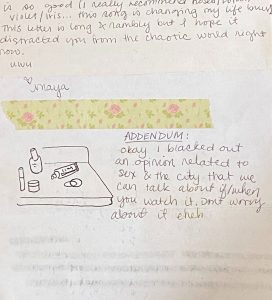
“These times are really intense. It’s really weird to be…going through a really historic time and being so conscious of it, and experiencing something so inescapable,” wrote Maya at the beginning of quarantine.
Next, she wrote an allusion to an episode of “Sex and the City,” with the plot line promptly redacted in case I hadn’t seen it. (I hadn’t.) We wrote about recipes, the time we went to Boston together and how “To All The Boys I’ve Loved Before” has a pretty good soundtrack. Maya later writes, “I can’t really put my finger on what exactly it [being penpals] gave to me but, it just felt really nice to connect with someone who I didn’t see daily and didn’t have to over explain things to, if that makes sense. Just nice stuff to read and see. Also sending weird stuff to surprise the other person is always fun. I think people need to value letter writing both to appreciate the USPS, and that sort of human connection between traveling conversation.”
Lately, I’ve been thinking about the narrative of a new normal, and the way things were even six months ago. As the possibility of cohesive change inches closer, the pandemic has become indicative of a society meant to be restructured. “I do not want to go back to our old ‘normal’. As we have seen during Corona, people have not been getting paid a living wage, not everyone is entitled to healthcare,” says Kiana. “It showed how minorities are disproportionately affected by pandemics, we saw certain sides of politics not wanting to wear masks at the expense of lower class essential workers. I do think a pandemic was essential for many Americans to realize it is time to make your voices heard in a defiance of a broken system.”
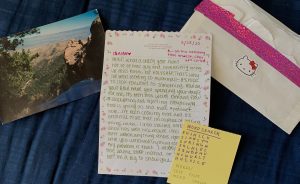
Selena is my roommate, and subsequently the person I quarantined with. Mail became something we did together, filling our coffee table with whatever art supplies we could find. I started buying stickers from the ’90s off of Etsy. Once I ran through the postcards we had been collecting from thrift stores, Selena and I got more creative, turning photos, images from magazines and old paper into postcards of our own.
“We were able to make little rituals and escape plans like postcard writing days and walks to the post office among other things. We had always been into sending and receiving mail and this seemed like the perfect time to share some love and care beyond usual digital communication,” says Selena. “[S]ince everything went digital it kind of made it harder for me to keep up with all the people I cared about and [being able to] express myself in texts or calls. Some kind of tech-fatigue, maybe. Mail always gave me something to look forward to, whether it’s knowing someone got the thing I doodled for them or getting an envelope of stickers from a friend.
“It definitely made me happy, gave me something to do that made other people happy, oh, and supported USPS. It was definitely linked to hope and keeping connections with people in different capacities — that was, and still is really important to me in the way I’ve learned to extend care to myself and others.”
It still feels a bit hollow to think of a pandemic becoming as a consistent part of our lives, and I know that no one wants to hear the word “unprecedented” ever again. We know. As July lurks around the corner, the best thing best I can do is to reflect on the small moments of bliss, a testament to the ability of adjusting.
Similarly, as the essence of community changes alongside both a social revolution and a pandemic, the process of being pen pals during a quarantine offers a method of reconnection in a way that challenges the fleeting nature of digital communication. Writing letters during quarantine helped make my days matter again, because I was giving someone something, even if I didn’t really know what it was.


